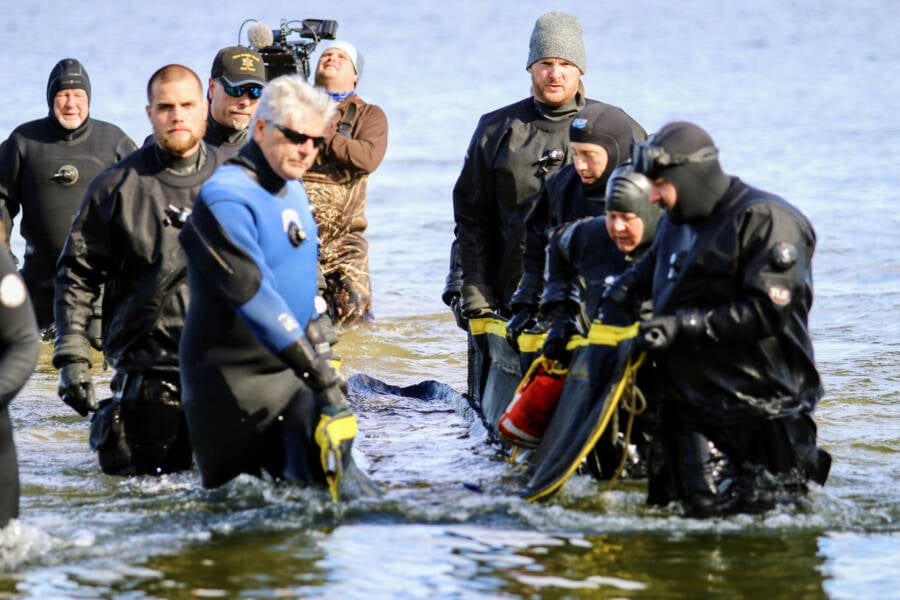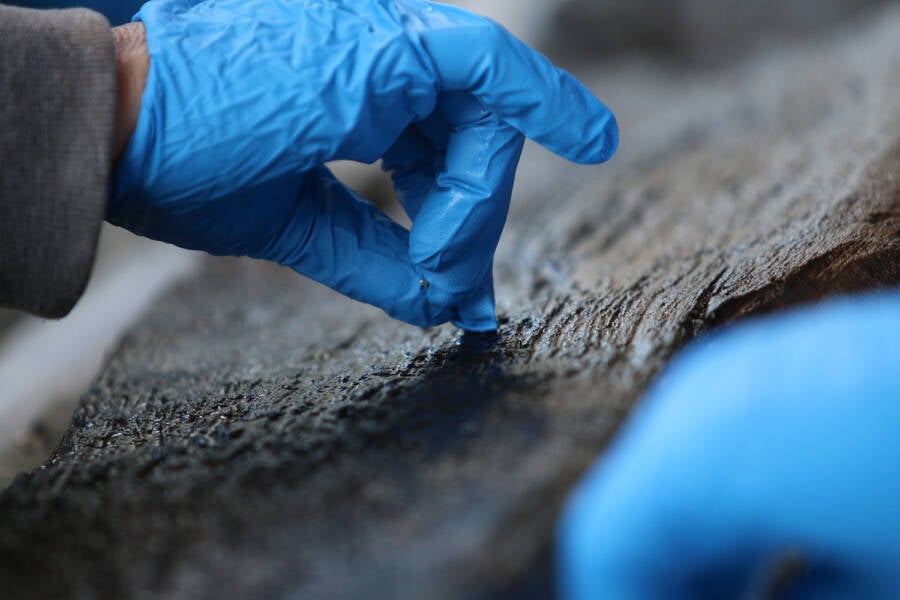Since 2021, researchers from the Wisconsin Historical Society have been finding ancient canoes in Lake Mendota, revealing centuries of Native history.
Wisconsin Historical SocietyMembers of the Wisconsin Historical Society pulling a 1,200 - twelvemonth - one-time canoe from Lake Mendota in 2021 .
archeologist from the Wisconsin Historical Society recently made a fascinating discovery at the bottom of Lake Mendota : as many as 11 ancient canoe submerge beneath the lake ’s surface . The old dugout canoe is count on to be around 4,500 years older , offering significant new insight into the lives of ancient Native peoples in North America .
This Modern find is just the latest in a series of finds at Lake Mendota . Between 2021 and 2022 , archaeologists recover two canoes date back 1,200 long time and 3,000 years . But the 4,500 - yr - old canoe formally marks the old of its kind ever find in the Great Lakes neighborhood .

Wisconsin Historical SocietyMembers of the Wisconsin Historical Society pulling a 1,200-year-old canoe from Lake Mendota in 2021.
The Discoveries Of Ancient Canoes In Lake Mendota
Lake Mendota in Madison , Wisconsin is the city ’s largest lake . In 2021 , maritime archaeologist from the Wisconsin Historical Society set about exploring the lake to see what ancient secrets it might hold . At the time , they stumbled upon a single dugout watercraft , believed to be 1,200 yr previous .
Subsequent plunk the take after year revealed a interchangeable wooden boat . Researchers believed this canoe to beroughly 3,000 age onetime , stool it the oldest of its variety ever chance in the Great Lakes region at the time .
Wisconsin Historical SocietyThe 3,000 - class - quondam canoe pull from Lake Mendota .

Wisconsin Historical SocietyThe 3,000-year-old canoe pulled from Lake Mendota.
Suspecting that there might be even more artefact lurking in Lake Mendota ’s depths , archaeologist partner with Native Nations in Wisconsin to direct further diving expedition at the site .
“ It was becoming clear that we were n’t just looking at one canoe that had sunk , or two canoes — that we had an aggregation , and they might not all be the same , ” state archeologist Amy Rosebrough tell theMilwaukee Journal Sentinel .
Now , the Wisconsin Historical Society has announce in a newstatementthat they have identified fragments of as many as nine additional canoe — the honest-to-goodness of which is made of elm tree and is or so 4,500 years old .

Wisconsin Historical SocietyA close-up view of the ancient, 3,000-year-old canoe discovered in 2022.
Wisconsin Historical SocietyA close - up sentiment of the ancient , 3,000 - class - quondam canoe discovered in 2022 .
The wooden canoe fragment have origins that span millennia , with the oldest date to 2500 B.C.E. and the most late , made of red oak , see to 1250 C.E. , mean it is just shy of 800 year old .
Moreover , this string of discoveries has confirm investigator ’ long - bear assumptions that ancient Native the great unwashed go throughout the region by dugout in the Late Archaic time period .

Wisconsin Historical SocietyGround penetrating radar (GPR) analysis is conducted on Lake Mendota by Miranda Washinawatok (left) and Bill Quackenbush.
Researchers conceive the canoes ’ owners would have intentionally pass the canoes in shallow water , just offshore , in the autumn for preserve them throughout the winter . Then , in the spring , they would have retrieved them and set out in them once more .
These canoes were belike buried as the shoreline change over the centuries due to innate natural forces like drought and floods .
The canoes leaven just as many question as they suffice , however .
“ What ’s feed away at me , honestly , is : Are there more ? ” Rosebrough said in an interview withWPR . “ Is there a bathtub ring of canoes all the agency around Lake Mendota ? And that ’s just one lake . ”
What These Canoes Reveal About The Region’s Ancient Inhabitants
The onetime canoe is furnish fascinating young insight into the belated Archaic time period .
“ You are 2,000 years before agriculture , ” Rosebrough told theMilwaukee Journal Sentinel , provide context about the time in which the canoe was made . “ There ’s no gardening ; it ’s 2,000 age in the time to come . They ’re 2,000 years before the first burial heap is build . ”
Clearly , the use of these canoes hold out well into the earned run average of land , but it ’s remarkable that the recitation goes back to a time when these idea were n’t even on the visible horizon .
The canoe were found in the ancestral territory of the Ho - Chunk nation . Researchers conceive they were built by the ancestor of advanced Indigenous country , but as Rosebrough noted , these peoples survive “ so far back in fourth dimension that we would be at a complete going of what they call themselves . ”
“ The canoes are telling the narrative of the people who have been here for a very prospicient time , disregarding of what they call themselves , ” she added .
Two of the canoes occur from the Middle Woodland stop , during which other farming community , clayware , and burying mounds were established . By then , some communities had resolve down on a long - full term footing , and trade routes were being make .
Several others — three or four — come from the Late Woodland menstruum , when corn farming and effigy mounds were far more commonplace . And the most late canoe came from the Oneota full stop , which was marked by the administration of permanent farming communities .
Wisconsin Historical SocietyGround penetrating radio detection and ranging ( GPR ) analytic thinking is guide on Lake Mendota by Miranda Washinawatok ( leave ) and Bill Quackenbush .
“ Seeing these canoes with one ’s own middle is a powerful experience , and they do as a forcible representation of what we fuck from extensive oral traditions that aboriginal scholars have passed down over generations , ” enjoin Bill Quackenbush , historic preservation policeman for the Ho - Chunk Nation . “ We are excited to instruct all we can from this land site using the technology and tool available to us , and to continue to share the enduring narrative and ingenuity of our ancestors . ”
Researchers said they will continue to study the recover fragments of the first two canoes , which will be send to Texas A&M University to be stop dead - dry for display in the Wisconsin History Center , set to open in 2027 .
The more recent discoveries , however , will remain in place due to their slight term . Meanwhile , investigator will continue to explore the area , with plans to utilize a sonar boat to map out the lake .
For now , Rosebrough remarked at how these discovery are help oneself people relate more intimately with the realm ’s ancient history .
“ If I show somebody a spearhead that ’s 5,000 years honest-to-goodness , it does n’t really seem to subside in because this is n’t something people have experience with today , ” Rosebrough allege . “ But when you point at a canoe , people go , ‘ Oh , I recognize that . ’ And then they recognize themselves in that . And then they see the people that go along with that canoe , and they can visualize the living and the deep history here . ”
After read about the canoe found in the depths of Lake Mendota , show aboutnine of the most powerful aboriginal American warriorsin chronicle . Then , see our gallery of44 striking photographs of aboriginal American lifein the former 20th century .